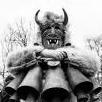
By Ero
in Self-Actualization Journals,
The following journal will be based on excerpts from the notes of my ongoing investigation into the paradigm of 'Chaos, Entropy, Order', seeking to establish the foundations of the upcoming transition from Tier 1 (deterministic and closed-form thinking) to Tier 2 (non-deterministic/stochastic emergence of macroscopic/holistic order). It is inspired by the long-forgotten history of my ancestry, namely the Orphic tradition and more specifically: the Orphic triad of Chaos, Eros and Gaia (termed by Ralph Abraham but miscategorized as Greek in origin).
Its primary purpose is that of a rigorous reformulation of contemporary Mathematics, Statistics and Theory of Computation (based on my background) by taking holistic and interdisciplinary inspiration from variety of topics and subjects, such as Statistical Mechanics, Measure Theory & Functional Analysis, Integrable Probability, Category Theory, Representation Theory, The Free Energy Principle, Active Inference, Bayesian Mechanics, Chaos Theory, QFT, Fluid Computing, etc. The format would be loose and free-flowing but primarily technical in nature.
Scientists, whose works serves as inspiration - Karl Friston, Michael Levin, Chris Fields, H, Haken, John Baez, Ilya Prigogine, David Spivak, S. Smirnov, A. Grothendieck, A, Kologomorov, A. Borodin, etc.
It has been by far the largest recontextualization in my neural net to date, combining years of experiences both in the spiritual and psychonaut, as well as the mathematical/ scientific realms. It has given me a decade-long purpose with both spiritual and technical realization.
Date of crystalization in consciousness: 18th of August, 2024
Main ideas
- First is the postulate of the fundamentally unknowable and intractable nature of Chaos, i.e the ontology of Consciousness in its primal form.
- The second is the postulate of entropy. From it follows the fact that Mathematics and Science are our generative models based on the sampling of Chaos through the Active Inference/Free-energy principle with the purpose of minimizing surprise (maximizing entropy). The principle implies a never-ending cycle of model building/refinement and eliminates the existence of a UFT/ToE, i.e an 'end to science' precisely.
Papers/books, such as 'On the statistical mechanics of life' or 'Every Life is on Fire', 'Evolution 2.0', 'Undeniable' examine more in depth the misconception entropy implies disorder - in fact the opposite - Life emerged as the most efficient driver of entropy:
'You start with a random clump of atoms, and if you shine light on it for long enough, it should not be so surprising that you get a plant' - Jeremy England
- Third is the postulate of abstraction/order - Reality as a Holon - described by the need to observe reality at different levels independently:
Quantum Fields -> Particles -> Atoms->Molecules-> Cells -> Tissue ->Organs -> Organisms -> Societies/herds/flocks-> Ecosystems-->...
Cognition/Intelligence is presence everywhere - from the smallest collective behavior of electrons, to the largest systems and networks.
Technical Foundations
The complexity we encounter in contemporary problems of energy, climate, societies and ecosystems cannot be handled by the contemporary human-centric, deterministic and closed-form solutions. The need for stochastic and emergent systems has become apparent. The theory would be based on the following technical undertakings:
- Transitioning from Hamiltonian (deterministic, trajectory-based) to Langevin dynamics (stochastic, probability-based) - Categorification of Probability Theory and Stochastic Systems, allowing for the abstraction of entropy/free-energy principle as a topological operad, applicable to any system, ranging from Plasma and Fluids, to Cellular and Biological networks, to contemporary AI models. - Embedding of the novel framework into appropriate computational paradigm, resting on the idea of Functorial bridges. - Transitioning away from Set Theory towards Topos-inspired foundations of mathematics, allowing to embed all current mathematical structures as macroscoping phenomena of miscroscopically-stochastic systems Each postulate and technical direction is sufficiently rich to warrant year-long investigations. For that purpose, my timeline and approach is very strategically adjusted based on my current technical background, as well as my vision for the next few years. Current scope of investigation - The rigorous foundations of Random Matrix Theory (Created by Wigner as part of the Statistical Physics of QFT) based on Heavy-Tailed distributions. The inspiration has been work by researchers at DeepMind, Gerard Ben Arous, and Charles Martin, the lattter of whom has empirically found direct connection with the weight matrices of NNs, and model performance, independent of training and testing data.
- Transitioning from Hamiltonian (deterministic, trajectory-based) to Langevin dynamics (stochastic, probability-based) - Categorification of Probability Theory and Stochastic Systems, allowing for the abstraction of entropy/free-energy principle as a topological operad, applicable to any system, ranging from Plasma and Fluids, to Cellular and Biological networks, to contemporary AI models. - Embedding of the novel framework into appropriate computational paradigm, resting on the idea of Functorial bridges. - Transitioning away from Set Theory towards Topos-inspired foundations of mathematics, allowing to embed all current mathematical structures as macroscoping phenomena of miscroscopically-stochastic systems Each postulate and technical direction is sufficiently rich to warrant year-long investigations. For that purpose, my timeline and approach is very strategically adjusted based on my current technical background, as well as my vision for the next few years. Current scope of investigation - The rigorous foundations of Random Matrix Theory (Created by Wigner as part of the Statistical Physics of QFT) based on Heavy-Tailed distributions. The inspiration has been work by researchers at DeepMind, Gerard Ben Arous, and Charles Martin, the lattter of whom has empirically found direct connection with the weight matrices of NNs, and model performance, independent of training and testing data.
- 16 replies